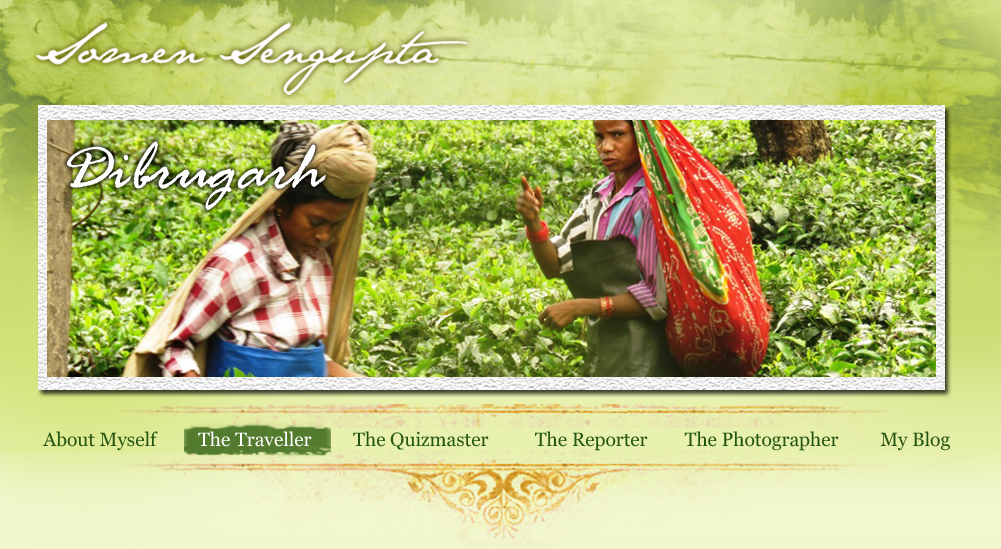|
The legacy of tea is best preserved in cities like Dibrugarh, and in the coming decades, the future generations will revel in its sinful, aromatic magic, writes SOMEN SENGUPTA
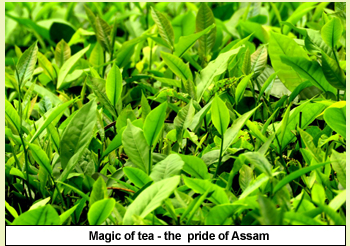 From the early part of the 19th century, imperial India was gradually becoming the centre of Britain’s global power. Thanks to the East India Company’s military might and all tricks to grab princely States of India one after another, the British rule under a business house was rapidly getting cemented from Mysore to the bank of Brahmaputra. It was an interesting time when after a prolonged Islamic rule, India was stepping into another era with a completely different model and outlook.
From the early part of the 19th century, imperial India was gradually becoming the centre of Britain’s global power. Thanks to the East India Company’s military might and all tricks to grab princely States of India one after another, the British rule under a business house was rapidly getting cemented from Mysore to the bank of Brahmaputra. It was an interesting time when after a prolonged Islamic rule, India was stepping into another era with a completely different model and outlook.
It was also the time when Britain was bleeding in commercial war with China after the opium war. China was slowly emerging as a giant in tea production. The commercial value of tea was gradually proving its worth and sharp traders like the Britishers were prudent enough to catch the business line. They threw their hats in the ring.
Britain’s experiment with tea in India started from the 1830s. The British East India Company tried to grow Chinese tea in India through one Colonel Robert Kyd in 1780 at Botanical Garden near Calcutta, but that experiment failed. In 1823, a Scottish soldier named Robert Bruce first noticed tea plants in the wild in Assam while he was a prisoner in the hands of the Burmese near Rongpur. He observed that a local tribe named Singpho drank its leaves after mixing in hot water. He handed over a few plants to his younger brother Charles Alexander Bruce in 1824 to send to Botanical Garden in Bengal and with that the economic history of Assam was changed forever. The plant was researched and a new type of tea was found. The official name of this new tea was camellia sinensis or in simple words, Assam tea.
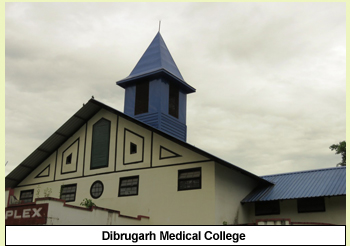 Though Darjeeling was a little advanced in producing tea for Britons (from 1834), Assam tea had its own journey of victory. It conquered its takers in its own style and taste from 1838. It landed at London in 1839 and from 1867 it became the first Indian crop to become commercialised. Assam emerged as a gold mine for the Brits for various commercial reasons. While heavy industrialisation was done in Bengal, this part was taken seriously for agricultural and natural resources. Coal, tea, oil, and timber — all commercial natural resources clicked right with Assam and a vast geography covering Dibrugarh, Shiv Sagar, and Tinsukia became the tea kingdom for British planters. Unbelievable as it may sound, the fact remains that today 55 per cent of India’s tea is produced in Assam from its 800 major and 42,000 minor tea estates spreading over 300000 hectares of land. Like many other towns of Assam, today tea and Dibrugarh are synonymous. Though Darjeeling was a little advanced in producing tea for Britons (from 1834), Assam tea had its own journey of victory. It conquered its takers in its own style and taste from 1838. It landed at London in 1839 and from 1867 it became the first Indian crop to become commercialised. Assam emerged as a gold mine for the Brits for various commercial reasons. While heavy industrialisation was done in Bengal, this part was taken seriously for agricultural and natural resources. Coal, tea, oil, and timber — all commercial natural resources clicked right with Assam and a vast geography covering Dibrugarh, Shiv Sagar, and Tinsukia became the tea kingdom for British planters. Unbelievable as it may sound, the fact remains that today 55 per cent of India’s tea is produced in Assam from its 800 major and 42,000 minor tea estates spreading over 300000 hectares of land. Like many other towns of Assam, today tea and Dibrugarh are synonymous.
A drive on NH37 and NH51 gives one a feeling that one is gliding over a green sea touching the last edge of the horizon. Nowhere in the world, except a few places in south China, can one see so many tea gardens. Dibrugarh and Jorhat together have developed a tea culture which is unmatched in India. Here tea is not just a crop, it is a part of people’s life and culture. Tea is not only taken as a steaming beverage, but also consumed as toffee, pill, cola and more. One should not be shocked to see a billboard in the city of Dibrugarh, the tea capital of India, which reads: “Better to be deprived of food for three days than tea for one.” Nowhere in India is tea given this level of dignity.
It is believed that the people of Ahom dynasty, that ruled Assam for more than 500 years, came from Thailand in the 13th century and first settled in Dibrugarh. If that is what we find in ancient history, the modern era gave Dibrugarh a new look under the British.
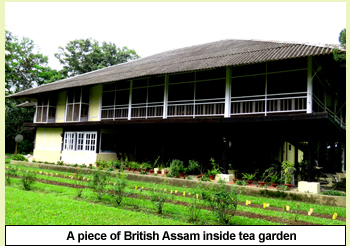 Apart from making it a tea hub, they also made it an important railway junction as soon as railway tracks were laid in Assam. In 1882, the first railway rolled from Dibrugarh to Steamer Ghat, and in December 1882, the first goods train rolled from here. Soon on February 18, 1884, the first passenger train with 400 Europeans and a few Indians moved from here to a place named Ledo. It was the time when most of the easily accessible places in Bombay, Bengal, and Madras presidencies had no railway track. This shows Dibrugarh’s paramount importance in British India. Apart from making it a tea hub, they also made it an important railway junction as soon as railway tracks were laid in Assam. In 1882, the first railway rolled from Dibrugarh to Steamer Ghat, and in December 1882, the first goods train rolled from here. Soon on February 18, 1884, the first passenger train with 400 Europeans and a few Indians moved from here to a place named Ledo. It was the time when most of the easily accessible places in Bombay, Bengal, and Madras presidencies had no railway track. This shows Dibrugarh’s paramount importance in British India.
Even today, in the context of Indian Railways, Dibrugarh occupies a unique position. This is the only non-capital city of India where Rajdhani Express, which is meant to connect the National Capital with all State Capitals, terminates and origins. Again, it this station from where India’s longest covering train, Vivekananda Express, starts to cover 4,278 km to reach Kanyakumari. Dibrugarh is a milestone in Indian Railways.
Assam’s first medical college was also opened in Dibrugarh by Sir John Benny White, a brigadier of British Army, in 1900. Then known as Benny White Medical School, it was finally converted into a medical college in 1938. The old building, in the typical Assam roofed-hut-with-a-tower style, still stands on the campus as a heritage building along with several modern buildings.
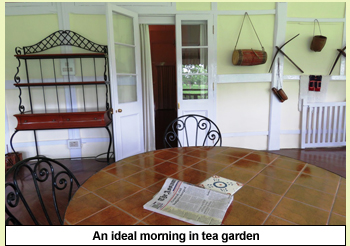 One side of the town is ruled by the river bank of Brahmaputra, which is 10 km wide here. The other side of the city is ruled by the lush green of tea gardens. In Dibrugarh, tea gardens are everywhere. The railway track, in the middle of the city, touches the shadow of green. While sitting on the window seat of a moving train, one can listen to vernacular songs of melancholy sung by the women working in tea gardens. More than 200 years ago, when these tea gardens were coming up, cheap labour was supplied from Bengal, Bihar, and Nepal. Till now, in the songs and poetry of these humble people, their sorrow and pain of migration plays. In their music, their exploitation at the hands of local contractors is also voiced. One side of the town is ruled by the river bank of Brahmaputra, which is 10 km wide here. The other side of the city is ruled by the lush green of tea gardens. In Dibrugarh, tea gardens are everywhere. The railway track, in the middle of the city, touches the shadow of green. While sitting on the window seat of a moving train, one can listen to vernacular songs of melancholy sung by the women working in tea gardens. More than 200 years ago, when these tea gardens were coming up, cheap labour was supplied from Bengal, Bihar, and Nepal. Till now, in the songs and poetry of these humble people, their sorrow and pain of migration plays. In their music, their exploitation at the hands of local contractors is also voiced.
From every corner of Dibrugarh, a tea garden peeps, and in every garden, colonial footprints still shine bright. One footprint is following the ‘tea time’, which is different from the Indian Standard Time (IST). Till now, all tea gardens of Dibrugarh, like other gardens of Assam, follow a time which is one hour ahead of the IST. As sunlight comes early in Assam, the working time also starts and ends an hour before the rest of India. This rule was started by British planters many years ago and is still in practice.
These tea gardens house several British bungalows, once a mark of pride of colonial rulers, and a completely isolated world for Indians. With change in times, these unique British bungalows have now been converted into luxury holiday nests. Tea tourism is a new stream that is rapidly expanding in upper tea gardens of Assam, Darjeeling, Sikkim, and some places in the South. We stayed in a heritage bungalow of a former tea estate manager, where nothing has changed except some items on the menu card. The aura of the Raj is palpable in these tea gardens and that has made tea tourism a new craze of our times.
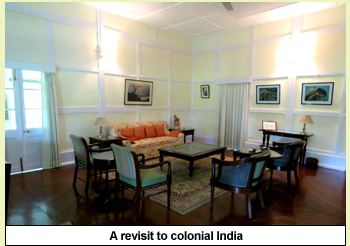 Dibrugarh has not missed the bus in this regard. Like any other place in Assam, like Jorhat and Tejpur, Dibrugarh also has its own treasures of British Assam. The Mancotta tea estate, which was once owned and managed by the Europeans, is now fully under Indians. The new owner has not allowed any change in the ambience of the tea garden and its residential wooden bungalow of the manager. This is a superbly decorated wooden house surrounded by tea gardens from all sides. Built on stilts, the house is supported on wooden logs with a purpose of protecting it from floods, tribal attack, insects and wild animals, like elephants and tigers. It is hard to imagine that India’s oldest surviving paramilitary force, the Assam Rifles, was formed in 1835 with 750 people to protect British tea planters from tribals and animals! Dibrugarh has not missed the bus in this regard. Like any other place in Assam, like Jorhat and Tejpur, Dibrugarh also has its own treasures of British Assam. The Mancotta tea estate, which was once owned and managed by the Europeans, is now fully under Indians. The new owner has not allowed any change in the ambience of the tea garden and its residential wooden bungalow of the manager. This is a superbly decorated wooden house surrounded by tea gardens from all sides. Built on stilts, the house is supported on wooden logs with a purpose of protecting it from floods, tribal attack, insects and wild animals, like elephants and tigers. It is hard to imagine that India’s oldest surviving paramilitary force, the Assam Rifles, was formed in 1835 with 750 people to protect British tea planters from tribals and animals!
The construction of this heritage house is unique and the interiors offer visitors a glimpse of the nostalgic time. The wooden floor, fire place, baby piano, cane furniture and a wall full of black and white photos of old Assam clearly display the rich past of the region. The engineering marvel of this bungalow executed by some Chinese designers is that there is not a single iron nail in the flooring.
The garden-facing balcony offers a 360 degree view of the ‘green sea’ with an occasional viewing of rare birds on the branches. The stairs from the ground floor to the landing of the first floor are decorated with tribal dolls, whereas in the first floor, a plethora of tribal musical instruments of Assam and arms used in various wars are displayed.
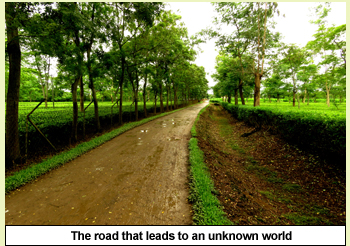 Every room is well furnished with thik or segun wood furniture with heavy curtains on the windows. The glass panes allow a lot of sunshine and unlimited view of the tea gardens covered under the shadow of majestic rain trees. The balcony and the tea table zone are nearby and both are blessed with sunshine till late afternoon. The last British manager staying in the excellent bungalow was Duncan Hayes. From 1970, with its handover to new management, the bungalow was gradually converted into a heritage place. Today, a stay in this bungalow is open to public but in limited numbers. Every room is well furnished with thik or segun wood furniture with heavy curtains on the windows. The glass panes allow a lot of sunshine and unlimited view of the tea gardens covered under the shadow of majestic rain trees. The balcony and the tea table zone are nearby and both are blessed with sunshine till late afternoon. The last British manager staying in the excellent bungalow was Duncan Hayes. From 1970, with its handover to new management, the bungalow was gradually converted into a heritage place. Today, a stay in this bungalow is open to public but in limited numbers.
A stay in a tea garden is an orientation to a lot of things. Apart from living in dense solitude and utter peace, the stay offers an insight into how these leaves and buds are converted into commercial crops, providing subsistence to so many people. In Mancotta tea garden, a tour can be done by car or on horseback. Bird-watching and watching people plucking tea leaves are common here. Over and above, the magic of relaxing on the sunny balcony with a cup of steaming tea and overlooking the green horizon is perhaps the biggest attraction of Dibrugarh’s tea tourism.
No such unwinding is complete without visiting a tea factory and understanding its processing from crude leave to packet CTC. Every big tea garden of Assam is backed with a self-sufficient tea factory. The labour-intensive industry has also adopted various mechanical machines that finally produce the best aromatic dust of the world.
Every tea factory proudly displays evolution in tea cultivation and its gradual booming history in India. Every factory is garnished with various colonial artifacts and furniture of that era. Even the tea testing rooms are loaded with various books, journals, maps, trophy of hunted animals in tea gardens, newspaper cutting and testing machines as old as 100 years. In a nutshell, a visit to these tea factories transports one to a different era that still shows how affectionately our colonial rulers had taken the business of tea. Their commercial interest was above all, but there is no doubt for that purpose they invested their funds and best brains that finally benefitted the large geography and population of India for several centuries.
Cities like Dibrugarh hold many such heritage relics that make them a magnet to attract people from India and abroad. There is no doubt that the legacy of tea is best preserved here under modern supervision, and in the coming decades, future generations will revel in its sinful magic. Dibrugarh rightfully stands with a unique testimony in its chest.
This article was published in The Pioneer on 1st April 2018
Click here to view the original article
|
